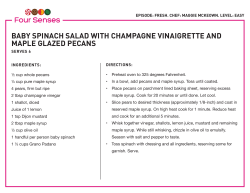
Document 159936
Stabilization of ph of Corn Syrup For Hard Candy By B, R. Suri, Grain Processing Corporation* ard candy is a solid syrup of sugar, corn syrup, acid, color and flavor to form a non-crystalline glass. Basically, a hard candy is a solid syrup of sugars with or without corn syrup having a solids content of 98 to 99.5 percent, dissolved in 0.5 to 2.0 percent water, color, flavor and acid. Hard candy has a wide range. The basic ingredients are sugar, corn syrup, a food acid, flavor and color. Remarkable strides have been made in the technology involving hard candy manufacturing. and a review of these developments is both timely and valuable. Ingredient suppliers, especially manufacturers of corn syrup and other corn products, have done a great deal of work during the past few years in the area of hard candies. As a result, a lot can now be done to improve the quality and shelf life of hard candy varieties. Today, the manufacture of hard candy is a highly complex, scientific operation. It involves the use of new types of sweeteners, flavors, production equipment, wrapping materials ,and wrapping and packaging machines. Good hard candy cannot be produced without an understanding of the nature of the ingredients and their chemical reactivity. Pure sugar, depending on how well refined it may be, contains less than 0.1 percent of ash, protein, invert sugars and moisture. Protein and invert sugar or reducing sugars may react in the browning or Maillard reaction. This reaction is very useful in toffee and caramels, but in hard candy, we try to avoid it. Thus, it is important to have low protein sugars. Ash and protein tend to stimulate foaming of boiled sugar solutions. Therefore, both must be low. Iron imparts color. M.B. Sherman first suggested that iron content should not exceed 3 ppm. Thus, the purity of sucrose will affect the quality of hard candy. Second and third melt sugar will carry higher reducing sugars and shoud be avoided. In the area of sweeteners, corn syrup has now replaced sugar as the basic ingredient. Most hard candy H 0Mr. Suri is now Mana er, CommercialProducts, Penick & Ford Limite%, Cedar Rapids, Iowa 32 formulations now call for a larger percentage of corn syrup than sugar and a few consist of 100 percent corn syrup. The corn refiners have done some very important work in this area; creating, developing and perfecting an important list of new types of syrups, some especially adaptable for various types of hard candy. Corn sgrups are used in hard candies to ( 1 ) Control and limit crystallization. (2) Control the sweetening level. (3) Add body and bulk, (4) Reduce cost. (5) Extend shelf life. (6) Give sheen. Regular corn syrup 42 DE 43° Baume is commonly used. However, a low DE corn syrup 34° to 38° DE is replacing regular 42 DE corn syrup, as the finished product using it is less sticky and has better shelf life. The ratio of sucrose to com syrup solids determines the reducing sugars in the final product. The temperature and humidity to which the product is subjected in the retail store where bought by the customer have an effect upon the reducing sugar. Too much reducing sugars will cause runny, sticky candies, whereas too little will not inhibit graining. Hard candy has a moisture content of 1.5 to 2 percent. The loss or gain of moisture during storage is the most important factor in the deterioration of candy. The amount of reducing sugars will help regulate moisture loss or gain through humectant activity. It has been established that the optimum percent of reducing sugars with which the finished candy will be in moisture equilibrium with prevailing relative humidities is from 14 to 18 percent. The reducing sugar in hard candy should be 14 to 18 percent. Most of the reducing sugar is supplied by the corn syrup and the rest obtained by the inversion of sucrose. Some corn syrups cause more inversion than others. Wider ranges of higher maltose corn syrups are adding to the versatility of corn syrup in hard candy use and other goods. The y have reversed the trend indicated several years ago toward a greater diversification into many specialized syrups. The single type may point the way to an ideal syrup, one which has optimum properties for all types of candies through its adaptability. It can be converted to the equivalent of high DE syrup by adding dextrose. 2 1st P. M.C.A. Production Conference, 1967
© Copyright 2025




















